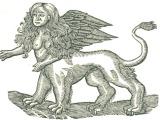Fabulous animals
|
Imaginations of fabulous animals were widespread throughout the world before the empirical scientific research from the Enlightenment onwards dismissed them as fantasies. Fabulous animals appear in the Bible and in works of naturalists as Aristotle and Pliny from Antiquity. From the classic work Physiologus (c. 200 AD) these imaginations wander further into the widespread popular Bestiaries of the Middle Ages, where animals and nature are interpreted in the world view of the Christian ethics. Fabulous animals were often composed of parts from real animals such as basilisk and griffin, or as a fusion of animal and man as in centaur and mermaid. The imaginations of fabulous animals may be caused by the human need to visualize the forces and conflicts in nature and in ourselves reflecting fear and fascination. Below examples of illustrations of imaginary creatures in a number of the library's older works. |
| C. Gesner: Historia animalium ... i 5 bind 1587-1617: |
 |
 |
 |
 |
||||
 |
 |
 |
 |
||||
 |
 |
 |
|||||
 |
 |
 |
 |
||||
 |
 |
 |
 |
||||
 |
 |
 |
 |
| C. Plinius: Bücher und Schriften von Natur ... 1600: |
 |
 |
 |
 |
|||
 |
 |
 |
 |
| A. Kircher: Mundus subterraneus ... 1664: |
 |
 |
 |
| C. Gesner: Allgemeines Thierbuch. 1668-69: |
 |
 |
 |
 |
| G.S. Winter: Tractatio .. re equaria ... 1687: |
 |
 |
 |
| J. Jonston: Theatrum animalium ... 1755: |
 |
 |
 |
 |
||||
 |
 |
 |
 |
| J. Jonston: Theatrum universale de avibus ... 1756: |
 |
 |
 |
 |


